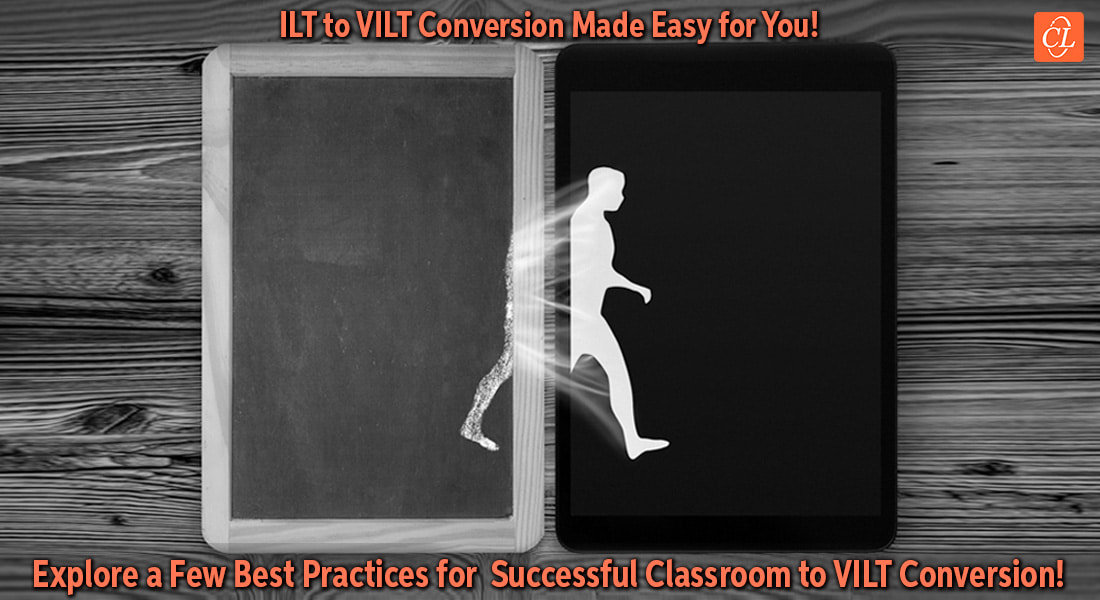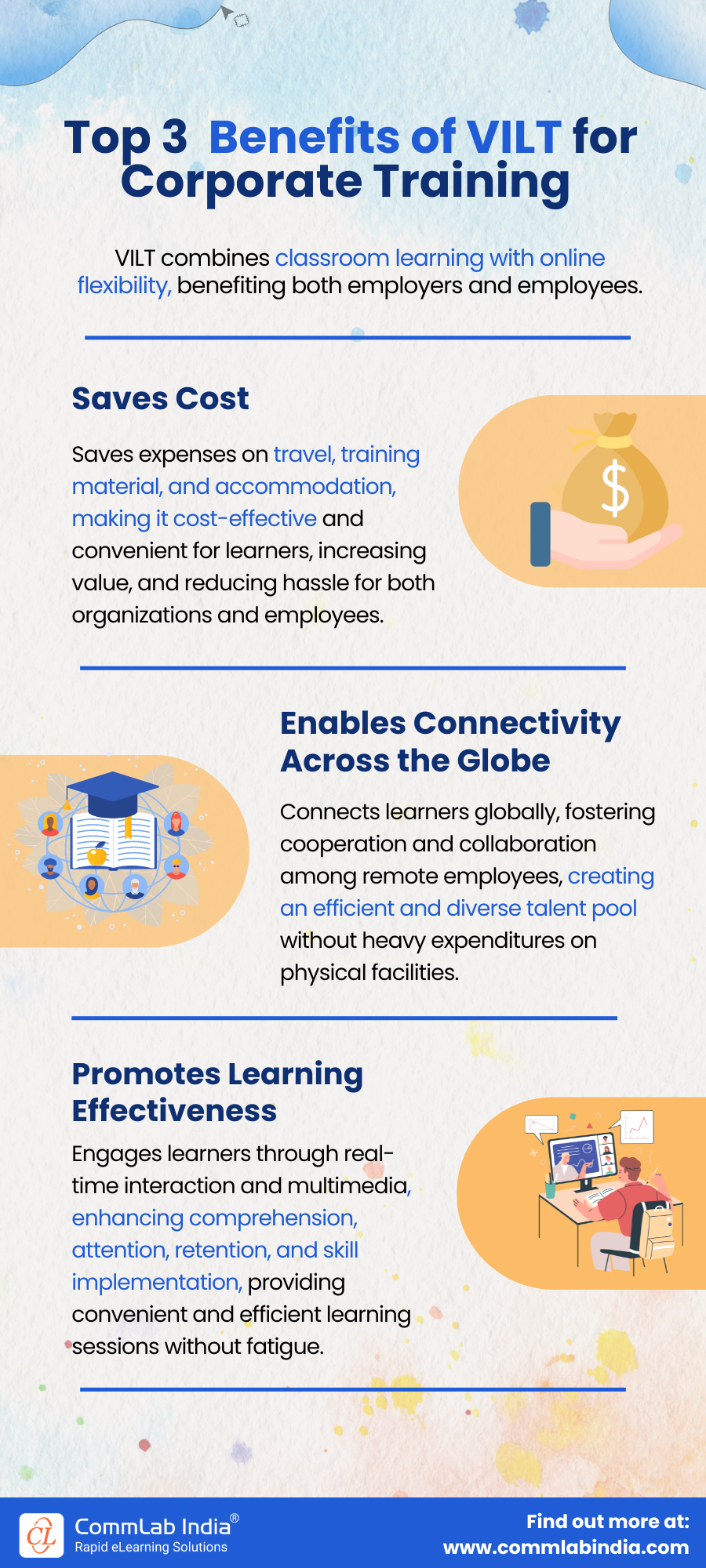How to Successfully Convert Classroom Training to VILT?
In the wake of the COVID-19 epidemic, organizations adopted a "work from home" strategy; "learning from home" needs to be given serious consideration. In this blog I will take you through the best practices of ILT to VILT conversion.

During the pandemic, organizations that had previously depended on in-person instructor-led training (ILT) were forced to immediately alter their approaches. Organizations had to swiftly adapt to ILT to virtual instructor-led (VILT) conversion. The world seemed to be gradually returning to normal. Many learning organizations won’t convert from VILT to ILT, although some may change their minds. In the first place, the change from ILT to VILT had already begun before the outbreak.
How to Make ILT to VILT Conversion Easy
Here are a few best practices:
- Select the Ideal Mediator
- Select a Rollout Strategy
- Get Your Learners Ready for Success
- Organize and Eliminate Unwanted Stuff
Numerous firms have learned from the COVID-19 epidemic that VILT is a successful method of employee training. After seeing how well online learning works for organizations and employees, many are now asking for long-term remote learning options.
What is Virtual Instructor-Led Training?
Online training and remote learning are not the same as virtual training. L&D specialists use simulated learning environments to deliver virtual training. These sessions work with self-paced trainings that incorporate simulation, gamification, 3D, virtual reality (VR), and augmented reality (AR). The VILT sessions are not seminars, they are not merely online presentations with polls, and they are not meetings held in a conference room.
Key Benefits of VILT:
Personalized Learning
delivers customized learning for each individual rather than using a one-size-fits-all strategy.
Flexible Learning
VILT allows learner to learn from anywhere and at any time.
Customized Learning
VILT configures training according to the roles and responsibilities of the learners.
Multigenerational Workforce Support
To accommodate their distinctive learning preferences, Millennials, Gen-Xers, and Boomers can all design their own learning pathways.
Are You Looking Forward to Replicating the Real Classroom, virtually? Here’s a Comprehensive Guide to Get You Going!
Do you, as a manager, also frequently receive inquiries from your other employees asking how quickly ILT can be converted to VILT? Here are a few most commonly asked questions and my answers to them.
Frequently Asked Questions About ILT to VILT Conversion
1. Is Classroom Training Instructor the Best Option for VILT?
If you are quickly transitioning training from classroom training room to the online training, you probably won’t have the option to recruit a new instructor. Since the majority of classroom instructors dislike travelling, VILT seems to win them over rather quickly.
These speeds up the shift from ILT to VILT. Of course, it differs from person to person, but for some, it fits wonderfully. They enjoy presenting and creating attention in this constrained time. Most online learning platforms include engagement metrics to enhance the presentation.
2. How Can Switching to Online Training Combat the Present Market Conditions if you Stick to Instructor-Led Training?
It can take a lot of work to move to remote virtual training. Start by restraining yourself from turning everything into a video. The operational phrase “move” is what really matters. Step back and concentrate on the most urgent requirement.
- What is necessary for this month or the following?
- What topics are in demand?
- Which of your professional development courses brings in the most money?
If you want to save money in the short term, interactive VILT sessions are the easiest distribution method to replicate the classroom experience. Please provide insightful, relevant information.
3. What are Some Risks Associated with Switching from ILT to VILT?
Taking too many professional development courses could be the biggest risk. Pick the ones that work best for you. Continue doing what you know you can do very well. You can succeed if you heed this advice. The best outcomes are produced through enthusiasm. Some of your learners might be unfamiliar with working remotely and may not feel completely at ease. Encourage cooperation and a sense of community among them.
VILT offers collaborative learning and social learning that engages learners. Collaborative learning helps in improving the workplace productivity, streamlines the workflow, allows the learners to work together and enhance the learning through interaction and it also allows the learners to share their knowledge with each other. Social learning allows learners to take charge of their learning experience and also engages them in continual learning experience.
Best Practices for Conversion from ILT to VILT
1. Select the Ideal Mediator
Even though the classes are online, instructors must still guide them. When an instructor works with an online moderator, the virtual experience runs more smoothly, allowing the instructor to concentrate on training and the moderator to aid with administrative communication. It’s crucial to choose an instructor who has experience teaching online courses or relevant training. In VILT, there are new technological elements that are distinct from face-to-face instruction, as well as a different pace that is crucial to nail in order to produce an immersive, successful, and efficient experience.
2. Select a Rollout Strategy
The process of transitioning your ILT programs to a virtual format is in multiple stages. It’s a huge task to roll out an entire training plan that converts eLearning material from one format to another; if you’re not diligent about analyzing your platforms and fixing the errors, it could result in a full setback. A good learner experience and VILT adoption are possible when the strategic planning is good.
3. Get Your Learners Ready for Success
By getting information prior to the training session that includes instructions for using various tools, who to contact in the event of a technical difficulty, and other crucial directions for the new virtual participants, learners can begin using their new virtual settings right away. You can include preview videos of the future course so that learners can watch them and get ready for the subsequent session.
4. Organize and Eliminate Unwanted Stuff
When switching from an ILT format to a VILT format, it’s a perfect chance to evaluate the curriculum and content you’ve been using and decide whether to eliminate or update it for the new instructional strategy. Have you ever been told in class or after a session that a particular aspect was dull or confusing? Do you realize that some components won’t work well in an online setting? Prior to completing your VILT syllabus, take into account eliminating or altering these sections.
To Conclude
Interaction and collaboration in a VILT session play a major role in stopping your learners from getting distracted. With a proper plan that focuses on the learner’s need, VILT can prove to be an effective and better way of learning when compared with instructor-led training. I hope you will be able to implement these practices into your conversion process of ILT to VILT.
For more insights on how to replicate your real classroom virtually, download this free eBook and find all the answers to your doubts.
Editor’s note: This post was originally published in June 2022 and has been updated for comprehensiveness.







